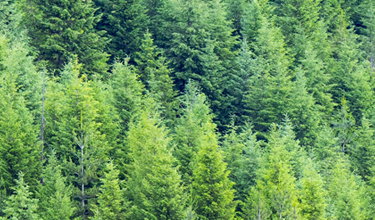
Case Studies:
Timberlands Environmental Management
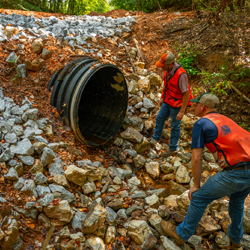
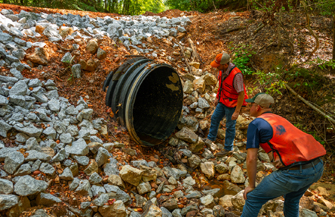
Using Bridges and Culverts
Each year, more than seven million tons of logs travel safely across PotlatchDeltic’s extensive network of forest roads, crossing numerous streams using approximately 39,000 culverts and 100 bridges. Responsibly managed stream crossings are essential to sustainable forestry operations. PotlatchDeltic carefully designs, constructs, and maintains stream crossings to protect water quality, while balancing optimal environmental performance and operational efficiency.
Regional conditions significantly influence PotlatchDeltic's stream crossing strategies. In Idaho, steep terrain and seasonal weather restrict road-building windows to approximately four months during the year. Culverts, sized based on drainage area, fish presence, and regulatory standards, are commonly used for crossings because they are cost effective and easy to install. Bridges, reserved for larger streams or challenging terrain, also provide essential fish passage and durability. Annual inspections and rigorous design standards ensure culverts and bridges perform reliably under Idaho’s Forest Practices Act.
In the U.S. South, flatter terrain and extensive water networks present different challenges. PotlatchDeltic increasingly utilizes portable bridges, representing an evolution from traditional methods for temporary crossings that required extensive creek bank disturbance and sedimentation management. Portable bridges, owned and deployed by the company, offer quicker installation and removal, significantly reduce sedimentation risks, and improve operational access. Contractors prefer these portable solutions for their operational efficiency, reduced cleanup requirements, and minimal environmental footprint.
Maintenance and inspection are ongoing commitments integral to PotlatchDeltic’s stream crossing management. Bridges are inspected annually by external engineers, while culverts undergo routine evaluations within landscape assessments conducted on three- to five-year rotations, depending on environmental risk factors such as landslide susceptibility. Additionally, culverts and crossings are proactively inspected before and after timber harvest operations to promptly identify and address potential environmental concerns.
Through strategically designed, constructed, and thoroughly maintained stream crossings, PotlatchDeltic effectively balances sustainable forest management practices with economic objectives, safeguarding water quality and aquatic ecosystems for future generations.
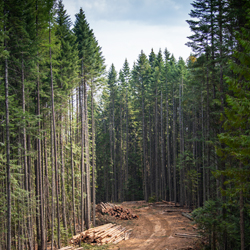
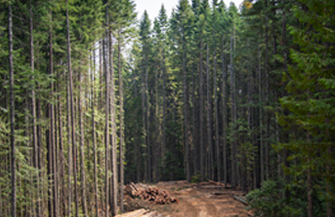
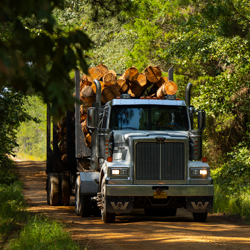
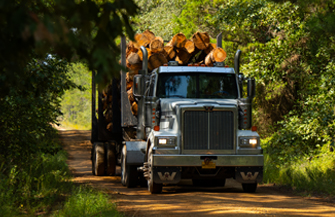
Road Construction
Correctly planning and constructing forest roads is an essential component of our environmental management programs. Roads are designed to manage the traffic load while minimizing environmental impact. We plan road construction using topographical maps, aerial photographs, and soil data to minimize disturbance to forest productivity, water quality, fish, and wildlife habitat.
Roads are planned to provide access for forest management and harvest with the least road length and width necessary and are located to avoid hazard areas and high-risk environmental areas such as swamps and unstable slopes. Following planning and design, trees are cleared from the areas where the road will be built. Trees removed during clearing are merchandized and hauled to mills for processing. The tops and limbs from the cleared trees are used as a slash filter windrow on the downslope side of the road fill to minimize soil movement.
Road construction requires the movement of soil to form a roadbed, road surface, and associated road ditches. We align the road to fit the natural terrain features as closely as possible so that the amount of soil movement is minimized. Construction techniques, culverts, and surface shaping techniques are utilized to limit the concentration of surface runoff and divert it away from roads and into the surrounding area in a way that minimizes effects to the watershed, streams, and fish. Exposed soil that has been shaped to form the road or roadsides is stabilized by seeding, compacting, or rocking the surface to minimize soil movement.
Stream crossings are minimized and whenever a road must cross a stream, the crossing is designed to provide for fish passage using techniques such as placing culverts so that they do not create an inlet or outlet drop that blocks fish movement and installing culverts at moderate gradients so that water velocities allow fish to swim through the pipe. For larger and steeper streams, additional structures such as arch culverts, bottomless culverts, or bridges are used so that the bottom of the stream is minimally disturbed, and flows are maintained. Regular preventive maintenance operations are conducted on roads to maintain use and minimize disturbance and damage to forest productivity, water quality, and fish and wildlife habitat.
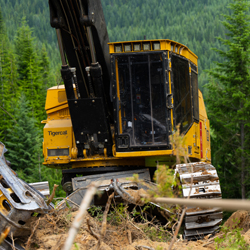
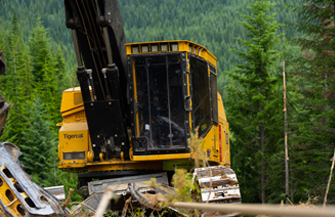
Tethered Logging in Idaho
Tethered or winch-assist logging systems are a relatively new technology being utilized on steep terrain and an approach that some of our contract loggers have adopted. In tethered systems, a winch is fitted to the harvester which is then utilized to allow the harvester to access slopes by tying to an anchor point and “climbing” down the side of the slope.
Our foresters identified the technology as an opportunity a few years ago and worked with the Idaho Department of Lands to obtain the Forest Practices Act changes to enable the use of these systems. Today, seven of our Idaho contractors are using winch-assist technology to log steep ground.
The winch-assist logging systems have been a large investment for our logging contractors. The logging system has several benefits, however, including improved safety with fewer workers exposed to traditional timber falling. Productivity and efficiency gains can also be captured as logging contractors generate higher daily production volumes in steep slope settings. Environmental benefits include less soil disturbance and compaction as ground pressure is reduced. Experience has also shown that the equipment is a valuable tool in constructing fire lines.
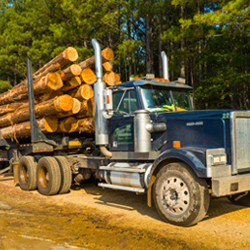
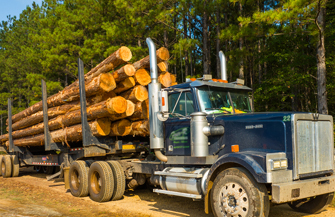
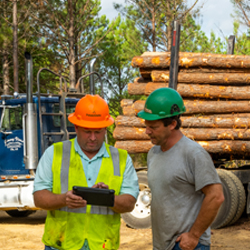
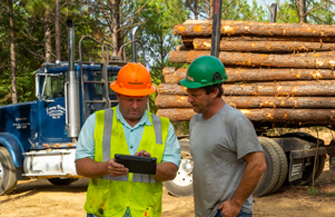
Monitoring Logging Contractors
To help ensure that we are operating responsibly on our property, we make sure that our logging contractors are trained professionals. All contractors must be approved to operate on our lands. In order to be approved, all logging contractors must have Qualified Logging Professional (QLP) status, insurance, and a master contract. QLP status requirements vary by state, as they are set by Sustainable Forestry Initiative® (SFI®) State Implementation Committees. Master contracts include commitments to Occupational Safety and Health Administration (OSHA) regulations, state, and federal laws, the SFI® standard, and the requirements of the Forest Stewardship Council® (FSC®) program, as well as our Supplier Code of Conduct. Per our policy, all these requirements must be in place before the contractors can begin operating on our land and are checked during internal and external audits. We perform annual contractor reviews and trainings to make sure everyone is up-to-date on new policies and procedures and to review priority issues.
Logging contractors are also monitored during harvest activities. Site Action Plans (SAPs) are prepared for every harvest and include objectives for the site such as forest management, tree retention for wildlife, streamside management zones, best management practices, and threatened and endangered species, cultural, or special site restrictions. The SAPs are discussed with the contractors before any work begins on the ground and are signed and dated by both the managing forester and the contractor to ensure understanding and expectations. Multiple harvest inspections occur throughout every harvest to ensure that all aspects of the SAP are being met as well as other objectives such as safety and site cleanliness.
Sustainable Forestry Initiative and SFI are registered marks owned by Sustainable Forestry Initiative Inc. Forest Stewardship Council and FSC are registered marks owned by The Forest Stewardship Council and are used pursuant to license code FSC-C102909.

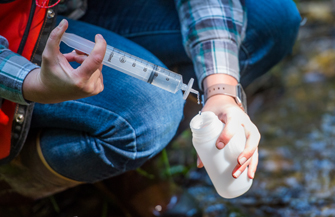
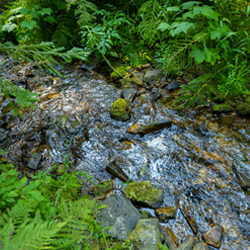

Mica Creek
Forests play a crucial role in collecting and filtering the water that countless organisms depend on — including humans. In our planting, harvesting, and road building, we take comprehensive measures to minimize sedimentation and runoff, with the goal of protecting the water quality and aquatic ecosystems. We follow each state’s prescribed “best management practices” as well as our own procedures that have been refined and improved over decades of research and science-based forestry. Following passage of the Clean Water Act in 1972, many states adopted forest management guidelines intended to reduce forestry’s negative effects on waters. At the time, there was little research showing whether these new guidelines worked.
That’s why PotlatchDeltic undertook a landmark study that was the first of its kind among U.S. forest products companies and remains one of the most comprehensive in length, scope and findings.
In 1990, with help from the U.S. Forest Service and the Idaho Department of Lands, we established the Mica Creek Experimental Watershed — an area southeast of Coeur d’Alene, Idaho, comprising the 6,672-acre catchments of Mica Creek, a tributary of the St. Joe River. While the watershed has been the site of numerous research projects over the years, we created this “living laboratory” for one main reason: to conduct a multi-decade study of the effects of modern forest best management practices on stream water quality and aquatic life.
Over the course of the study, we have worked with scientists from the University of Idaho and other academic institutions to collect data on the effects of tree harvesting, road building, and other practices. The results of that research are published in independent, peer-reviewed academic journals such as Forest Science and presented at scientific conferences. In our leadership roles serving on the Idaho Forest Practices Act Committee we work to incorporate the results of the Mica research into effective and efficient Forest Practices Act rules. The conclusions to date are encouraging. They show that forest management that adheres to contemporary best management practices has little to no adverse effect on streams aquatic life.
Key Findings of Mica Research
- Stream flows generally increase modestly following tree harvests.
- Stream temperature in fish-bearing streams within summer.
- Measurable suspended sediment increases in the first levels.
- Forest management that adheres to contemporary best practices has no detrimental effect on fish, amphibians, or aquatic insect communities.
The findings from the first 25 years of research comparing treated versus control stands has been summarized and published in numerous scientific journals. In collaboration with the University of Idaho, we continue to collect data on water flow, sedimentation, fish, and other key environmental conditions in the Mica Creek watershed. The watershed is now being managed as a working forest – the forestlands that we harvest, replant, and manage for sustainable production of timber. The research and monitoring that is being conducted now provides an ongoing evaluation of the effectiveness of contemporary best management practices.
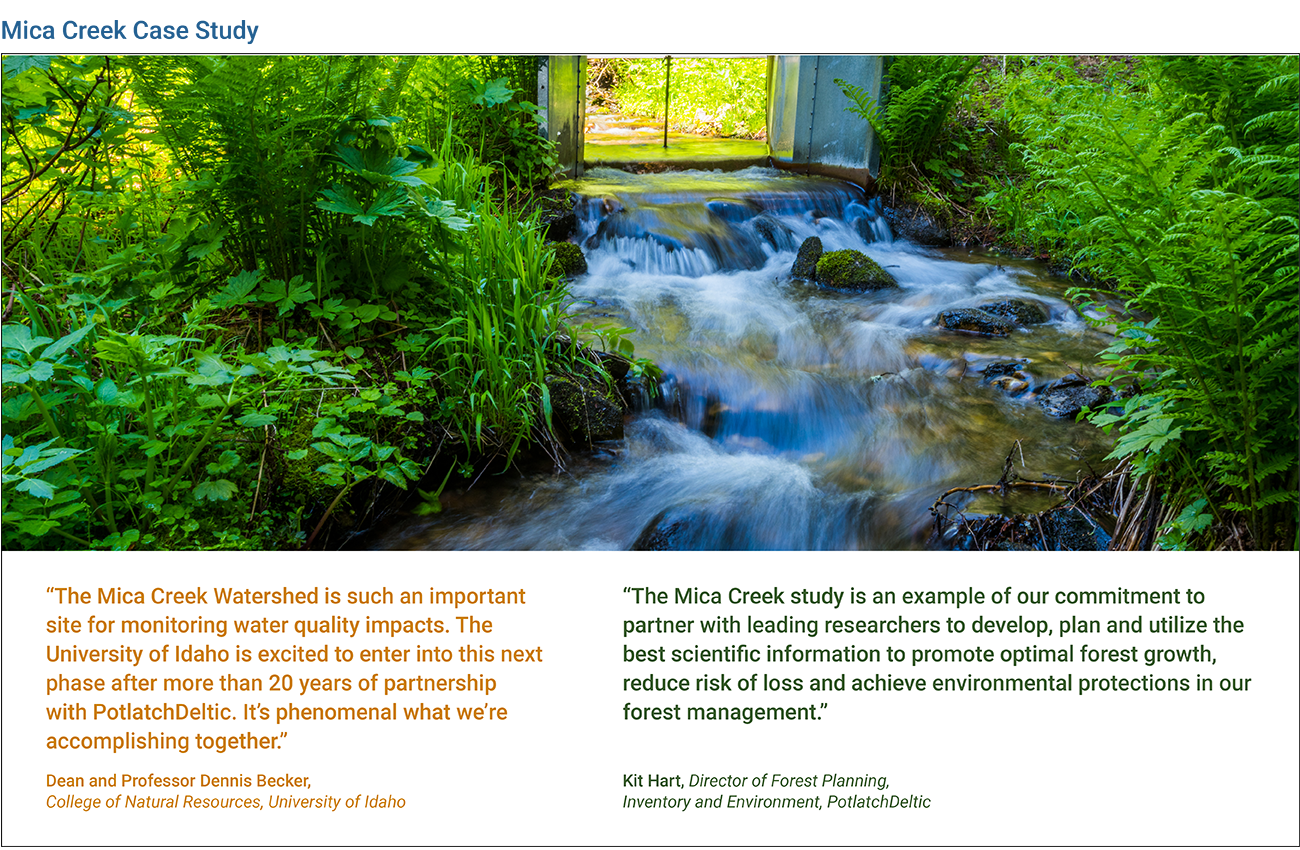
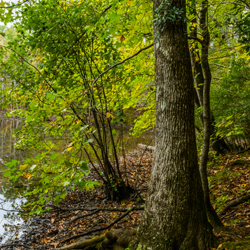
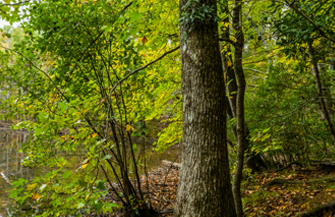
Establishing Hardwood SMZs
Forestry best management practices (BMPs) are voluntary practices that forestry professionals follow to protect water quality in the areas that they manage. In Georgia and Alabama, BMPs require that the litter layer on top of the soil be left on ephemeral channels when trees are harvested along ephemerals. Ephemeral channels are channels formed by water during or immediately after a precipitation event where the top layer of the forest floor is disturbed, and soil is exposed. Previous owners of one of our tracts had harvested all the pine and hardwood trees from along the ephemeral ditches and then converted the area to pine plantation. Our foresters identified areas where the prior conversion risked increased erosion and decided to establish them as hardwood streamside management zones (SMZs).
To achieve this transition back to hardwood, a buffer was established as an additional protected area. The existing pine was removed from the buffer area and all hardwood currently growing inside the buffer area was protected. The growth of the hardwood inside the newly established buffer area was aided by additional sunlight that reached the trees due to the removal of the pines. The buffer areas are recorded and protected as young hardwood stands in our GIS mapping system and are allowed to grow freely into riparian hardwood buffers. We believe that this enhances water quality, wildlife habitat, and biodiversity.
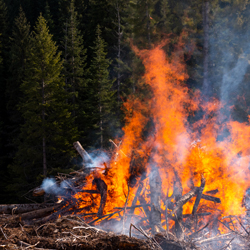
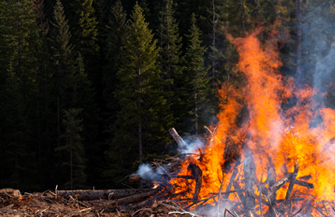
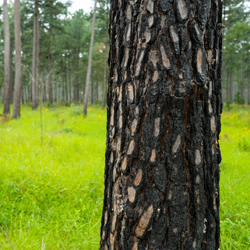
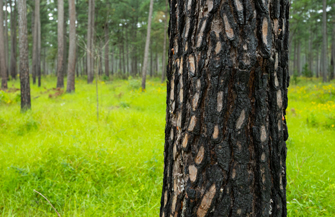
Using Fire
Fire is an important forest management tool for removing post-logging woody debris known as slash and to help prepare sites for replanting. Low-intensity ground fires can be used to control vegetation, while bark provides thermal insulation from the fire for overstory trees. The seeds of some plants will only break dormancy when signaled by smoke and charred plant matter, while others may only flower after a fire. Fire also provides nutrient recycling through the char left behind, reduces insect and disease risk, and can promote diversity for wildlife by creating a mosaic of habitats. The use of low-intensity fires in managed working forests can also help reduce the risk of high-intensity catastrophic wildfires.
We utilize fire differently in our Idaho and southern timberlands. In Idaho, we are required under the Forest Practices Act to remove slash after harvest to reduce fire, insect, and disease risk, and to optimize regeneration conditions. In our southern timberlands, fire is used less frequently, with logging slash typically left to decay on the forest floor without posing a fire risk.
Use of low-intensity fire to reduce fuel load and lessen wildfire risk can be accomplished through prescribed burns or through pile burns. Burns are planned when fuel moisture, relative humidity, air temperature, wind speed, wind direction, and smoke dispersion are within prescribed ranges. Burns are typically done in the late fall or early spring outside of the fire season.
Prescribed fires are designed to stay within a pre-determined area and are continuous across the landscape. We minimize using prescribed burning in Idaho due to safety and fire risks, using it in situations such as on steeper ground with heavy slash where other removal options are limited. We occasionally use prescribed fire in our southern timberlands to achieve specific biodiversity objectives for species that require fire-maintained habitat. In the South, warm and wet conditions enable us to typically leave slash and return nutrients to the soil.
Pile burning fires are used in Idaho to reduce postharvest slash and to create fire lines or fuel breaks as a mitigation measure for wildfire. Our foresters evaluate fuel loading to determine areas where slash needs to be piled within a harvested area and piling is done with an excavator.
Regardless of method chosen, approvals are required for burns in Idaho, and fires are only accomplished in appropriate weather conditions. In Idaho, we are members of the Montana Idaho Airshed Group, which was formed to limit the impacts of smoke from fire used as a working forest management tool. Members consist of federal, state, and tribal agencies; industrial forest owners; and a non-profit organization who work to proactively protect air quality. The units to be burned are submitted, along with information describing the amount of fuel to be burned, location and elevation of unit, type of burn, and number of acres. The airshed group program coordinator and a meteorologist determine which airsheds (similar geographic areas of the same topography, elevation, and weather patterns) have restrictions on burning on a given day and give approval for requested burns.
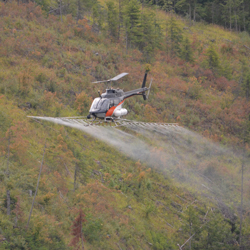
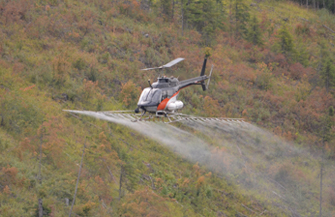
Use of Herbicides
Chemicals used in our forest management include herbicides to manage weeds or competing vegetation in order to allow seedlings to survive and grow and return the treated area to a forest as rapidly as possible. Herbicides are also used in forestry to control invasive plant species. Occasionally, pesticides are utilized for insects and disease. Fertilizers can be applied to promote growth when conditions warrant. We apply all chemicals in a way that does not endanger aquatic and terrestrial habitats and we safeguard streams and streamside vegetation through buffers and other protective measures.
Herbicide types, rates, and application methods for each treatment area are determined by evaluating site-specific conditions and the competing vegetation targeted for control. Prior to application, we inspect each site for water bodies and provide detailed maps to applicators of any sensitive areas with boundaries of the area to be treated clearly delineated. Property line buffers and buffers along water are included on the application maps. Forestry herbicides are applied by tractors, helicopters, and by hand depending on the site. All applications are made by licensed applicators.
As part of our focus on stakeholder engagement, we notify neighboring property owners in Idaho of our intent to spray, provide information on the proposed treatment, and file all requirements with state regulatory agencies.


